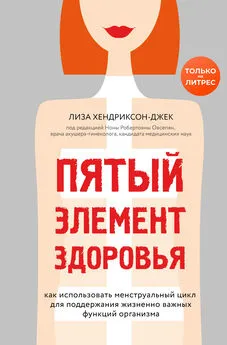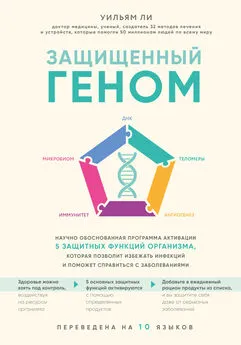Лиза Хендриксон-Джек - Пятый элемент здоровья. Как использовать менструальный цикл для поддержания жизненно важных функций организма
- Название:Пятый элемент здоровья. Как использовать менструальный цикл для поддержания жизненно важных функций организма
- Автор:
- Жанр:
- Издательство:Литагент 5 редакция
- Год:2020
- Город:Москва
- ISBN:978-5-04-104425-1
- Рейтинг:
- Избранное:Добавить в избранное
-
Отзывы:
-
Ваша оценка:
Лиза Хендриксон-Джек - Пятый элемент здоровья. Как использовать менструальный цикл для поддержания жизненно важных функций организма краткое содержание
«Почти» – потому что у женщин есть пятый показатель здоровья, на который, к сожалению, все еще мало кто обращает внимание, – это менструальный цикл. Короткий или длинный, регулярный или непредсказуемый – цикл может быть очень разным, и каждый его параметр, каждое изменение служат индикатором той или иной проблемы в организме. Планируете вы беременность или нет, овуляция имеет значение для поддержания здоровья.
Автор этой книги расскажет, что именно влияет на состояние менструального цикла, и научит вас составлять его график для максимально точного и удобного отслеживания различных изменений и контроля здоровья.
Пятый элемент здоровья. Как использовать менструальный цикл для поддержания жизненно важных функций организма - читать онлайн бесплатно ознакомительный отрывок
Интервал:
Закладка:
46. Purchas, R.W., S.M. Rutherfurd, P.D. Pearce, R. Vather, and B.H.P. Wilkinson. “Concentrations in beef and lamb of taurine, carnosine, coenzyme Q10, and creatine.” Meat Science 66, no. 3 (2004): 629–637.
47. Hammiche, Fatima, Marijana Vujkovic, Willeke Wijburg, Jeanne H.M. de Vries, Nick S. Macklon, Joop S.E. Laven, and Régine P.M. Steegers-Theunissen. “Increased preconception omega-3 polyunsaturated fatty acid intake improves embryo morphology.” Fertility and Sterility 95, no. 5 (2011): 1820–1823; Chiu, Y.H., A.E. Karmon, A.J. Gaskins, M. Arvizu, P.L. Williams, I. Souter, B.R. Rueda, R. Hauser, J.E. Chavarro, and EARTH Study Team. “Serum omega-3 fatty acids and treatment outcomes among women undergoing assisted reproduction.” Human Reproduction 33, no. 1 (2017): 156–165; Nehra, Deepika, Hau D. Le, Erica M. Fallon, Sarah J. Carlson, Dori Woods, Yvonne A. White, Amy H. Pan et al. “Prolonging the female reproductive lifespan and improving egg quality with dietary omega-3 fatty acids.” Aging Cell 11, no. 6 (2012): 1046–1054; Skaznik-Wikiel, M.E., D.C. Swindle, T.K. Soderborg, J.E. Friedman, and A.J. Polotsky. “Increased tissue omega-3 to omega-6 fatty acid ratio results in improved markers of ovarian reserve and altered systemic cytokines.” Fertility and Sterility 106, no. 3 (2016): e121; Bauer, J.L., K. Kuhn, Z. Al-Safi, M.A. Harris, R.H. Eckel, A.P. Bradford, C.Y. Robledo, A. Malkhasyan, N. Gee, and A.J. Polotsky. “Omega-3 fatty acid supplementation significantly lowers FSH in young normal weight women.” Fertility and Sterility 108, no. 3 (2017): e257–e258; Price, Weston A. (2016). Nutrition and Physical Degeneration, 8th edition. Lemon Grove, CA: Price-Pottenger Nutrition Foundation, 362.
48. Griswold, Michael D., Cathryn A. Hogarth, Josephine Bowles, and Peter Koopman. “Initiating meiosis: the case for retinoic acid.” Biology of Reproduction 86, no. 2 (2012): 35.
49. Irani, Mohamad, and Zaher Merhi. “Role of vitamin D in ovarian physiology and its implication in reproduction: a systematic review.” Fertility and Sterility 102, no. 2 (2014): 460–468.
50. Ozkan, Sebiha, Sangita Jindal, Keri Greenseid, Jun Shu, Gohar Zeitlian, Cheryl Hickmon, and Lubna Pal. “Replete vitamin D stores predict reproductive success following in vitro fertilization.” Fertility and Sterility 94, no. 4 (2010): 1314–1319; Zhao, Jing, Xi Huang, Bin Xu, Yi Yan, Qiong Zhang, and Yanping Li. “Whether vitamin D was associated with clinical outcome after IVF/ICSI: a systematic review and meta-analysis.” Reproductive Biology and Endocrinology 16, no. 1 (2018):13, 1–7; Lata, Indu, Swasti Tiwari, Amrit Gupta, Subhash Yadav, and Shashi Yadav. “To study the vitamin D levels in infertile females and correlation of Vitamin D deficiency with AMH levels in comparison to fertile females.” Journal of Human Reproductive Sciences 10, no. 2 (2017): 86–90.
51. Jiménez Tuñón, Juan Manuel, Paloma Piqueras Trilles, Miguel Gallardo Molina, María Hebles Duvison, Beatriz Migueles Pastor, Pascual Sánchez Martín, Fernando Sánchez Martín, and Rafael Sánchez-Borrego. “A double-blind, randomized prospective study to evaluate the efficacy of previous therapy with melatonin, myo-inositol, folic acid, and selenium in improving the results of an assisted reproductive treatment.” Clinical Medicine Insights: Therapeutics 9 (2017): 1179559X17742902; Cheraghi, Ebrahim, Malek Soleimani Mehranjani, Mohammad Ali Shariatzadeh, Mohammad Hossein Nasr Esfahani, and Zahra Ebrahimi. “N-acetylcysteine improves oocyte and embryo quality in polycystic ovary syndrome patients undergoing intracytoplasmic sperm injection: an alternative to metformin.” Reproduction, Fertility and Development 28, no. 6 (2016): 723–731.
52. Tsui, Kuan-Hao, Peng-Hui Wang, Li-Te Lin, and Chia-Jung Li. “DHEA protects mitochondria against dual modes of apoptosis and necroptosis in human granulosa HO23 cells.” Reproduction 154, no. 2 (2017): 101–110; Hyman, Jordana H., Ehud J. Margalioth, Ron Rabinowitz, Avi Tsafrir, Michael Gal, Sarah Alerhand, Nurit Algur, and Talia Eldar-Geva. “DHEA supplementation may improve IVF outcome in poor responders: a proposed mechanism.” European Journal of Obstetrics and Gynecology and Reproductive Biology 168, no. 1 (2013): 49–53.
53. Showell, Marian G., Julie Brown, Jane Clarke, and Roger J. Hart. “Antioxidants for female subfertility.” The Cochrane Library (2013): 1–154.
54. Pasupuleti, Visweswara Rao, Lakhsmi Sammugam, Nagesvari Ramesh, and Siew Hua Gan. “Honey, propolis, and royal jelly: a comprehensive review of their biological actions and health benefits.” Oxidative Medicine and Cellular Longevity 2017: 1–21.
55. Hampton, Kerry D., Danielle Mazza, and Jennifer M. Newton. “Fertility-awareness knowledge, attitudes, and practices of women seeking fertility assistance.” Journal of Advanced Nursing 69, no. 5 (2013): 1076–1084.
56. Hendrickson-Jack, Lisa. “FFP 070 | Healing, Illness, Fertility & Pregnancy | Getting to the Root Cause | Dr. Thomas Cowan.” Fertility Friday Podcast. Podcast Audio, March 25, 2016. fertilityfriday.com/70.
57. Kumar, Naina, and Amit Kant Singh. “Trends of male factor infertility, an important cause of infertility: a review of literature.” Journal of Human Reproductive Sciences 8, no. 4 (2015): 191–196.
58. Stukenborg, Jan-Bernd, Kristín Rós Kjartansdóttir, Ahmed Reda, Eugenia Colon, Jan Philipp Albersmeier, and Olle Söder. “Male germ cell development in humans.” Hormone Research in Paediatrics 81, no. 1 (2014): 2–12.
59. Hendrickson-Jack, Lisa. “FFP 134 | Optimizing Sperm Health | Motility, Morphology & Sperm Count | Why He Needs to Get Tested ASAP | Marc Sklar.” Fertility Friday Podcast. Podcast Audio, April 28, 2017. fertilityfriday.com/134.
60. Guzick, David S., James W. Overstreet, Pam Factor-Litvak, Charlene K. Brazil, Steven T. Nakajima, Christos Coutifaris, Sandra Ann Carson et al. “Sperm morphology, motility, and concentration in fertile and infertile men.” New England Journal of Medicine 345, no. 19 (2001): 1388–1393.
61. World Health Organization. “WHO laboratory manual for the examination and processing of human semen.” (2010).
62. Gardner, David K., Ariel Weissman, Colin M. Howles, and Zeev Shoham. Textbook of Assisted Reproductive Techniques: Laboratory and Clinical Perspectives. Informa Healthcare, 2009: 39–50; Lishko, Polina V., and Nadja Mannowetz. “CatSper: a unique calcium channel of the sperm flagellum.” Current Opinion in Physiology 2 (2018): 109–113; Sing, Akhand P., and Singh Rajender. “CatSper channel, sperm function and male fertility.” Reproductive BioMedicine Online 30, no. 1 (2015): 28–38; Aitken, R. John, Fiona S.M. Best, Pamela Warner, and Alan Templeton. “A prospective study of the relationship between semen quality and fertility in cases of unexplained infertility.” Journal of Andrology 5, no. 4 (1984): 297–303.
63. Menkveld, Roelof. “Clinical significance of the low normal sperm morphology value as proposed in the fifth edition of the WHO Laboratory Manual for the Examination and Processing of Human Semen.” Asian Journal of Andrology 12, no. 1 (2010): 47–58.
64. Durairajanayagam, Damayanthi, Ashok Agarwal, and Chloe Ong. “Causes, effects and molecular mechanisms of testicular heat stress.” Reproductive Biomedicine Online 30, no. 1 (2015): 14–27.
65. Zhang, M.-H., L.-P. Zhai, Z.-Y. Fang, A.-N. Li, Y. Qiu, and Y.-X. Liu. “Impact of a mild scrotal heating on sperm chromosomal abnormality, acrosin activity and seminal alpha-glucosidase in human fertile males.” Andrologia 50, no. 4 (2018): e12985.
66. Mieusset, R., and L. Bujan. “Testicular heating and its possible contributions to male infertility: a review.” International Journal of Andrology 18, no. 4 (1995): 169–184.
67. Künzle, Robert, Michael D. Mueller, Willy Hänggi, Martin H. Birkhäuser, Heinz Drescher, and Nick A. Bersinger. “Semen quality of male smokers and nonsmokers in infertile couples.” Fertility and Sterility 79, no. 2 (2003): 287–291.
68. Gundersen, Tina Djernis, Niels Jørgensen, Anna-Maria Andersson, Anne Kirstine Bang, Loa Nordkap, Niels E. Skakkebæk, Lærke Priskorn, Anders Juul, and Tina Kold Jensen. “Association between use of marijuana and male reproductive hormones and semen quality: a study among 1,215 healthy young men.” American Journal of Epidemiology 182, no. 6 (2015): 473–481.
69. Muthusami, K.R., and P. Chinnaswamy. “Effect of chronic alcoholism on male fertility hormones and semen quality.” Fertility and Sterility 84, no. 4 (2005): 919–924.
70. Agarwal, Ashok, Fnu Deepinder, Rakesh K. Sharma, Geetha Ranga, and Jianbo Li. “Effect of cell phone usage on semen analysis in men attending infertility clinic: an observational study.” Fertility and Sterility 89, no. 1 (2008): 124–128.
71. Rubio, C., I. Campos-Galindo, R. Rivera Egea, N. Garrido, C. Simon, and F. Dominguez. “Effect of environmental endocrine disruptor’s exposure on sperm quality and aneuploidy rates in fertile sperm donors.” Fertility and Sterility 106, no. 3 (2016): e28–e29.
72. Rahman, Md Saidur, Woo-Sung Kwon, June-Sub Lee, Sung-Jae Yoon, Buom-Yong Ryu, and Myung-Geol Pang. “Bisphenol-A affects male fertility via fertility-related proteins in spermatozoa.” Scientific Reports 5 (2015): 9169.
73. Wise, Lauren A., Daniel W. Cramer, Mark D. Hornstein, Rachel K. Ashby, and Stacey A. Missmer. “Physical activity and semen quality among men attending an infertility clinic.” Fertility and Sterility 95, no. 3 (2011): 1025–1030; Safarinejad, Mohammad Reza, Kamran Azma, and Ali Asgar Kolahi. “The effects of intensive, long-term treadmill running on reproductive hormones, hypothalamus – pituitary – testis axis, and semen quality: a randomized controlled study.” Journal of Endocrinology 200, no. 3 (2009): 259–271.
74. Busada, Jonathan T., and Christopher B. Geyer. “The role of retinoic acid (RA) in spermatogonial differentiation.” Biology of Reproduction 94, no. 1 (2016): 10-1; Chung, S.S.W., and D.J. Wolgemuth. “Role of retinoid signaling in the regulation of spermatogenesis.” Cytogenetic and Genome Research 105, no. 2–4 (2004): 189–202.
75. Fallah, Ali, Azadeh Mohammad-Hasani, and Abasalt Hosseinzadeh Colagar. “Zinc is an essential element for male fertility: a review of Zn roles in men’s health, germination, sperm quality, and fertilization.” Journal of Reproduction & Infertility 19, no. 2 (2018): 69–81; Colagar, Abasalt Hosseinzadeh, Eisa Tahmasbpour Marzony, and Mohammad Javad Chaichi. “Zinc levels in seminal plasma are associated with sperm quality in fertile and infertile men.” Nutrition Research 29, no. 2 (2009): 82–88; Wallock, Lynn M., Tsunenobu Tamura, Craig A. Mayr, Kelley E. Johnston, Bruce N. Ames, and Robert A. Jacob. “Low seminal plasma folate concentrations are associated with low sperm density and count in male smokers and nonsmokers.” Fertility and Sterility 75, no. 2 (2001): 252–259; Chia, S.-E., C.N. Ong, L.-H. Chua, L.-M. Ho, and S.-K. Tay. “Comparison of zinc concentrations in blood and seminal plasma and the various sperm parameters between fertile and infertile men.” Journal of Andrology 21, no. 1 (2000): 53–57.
76. Wong, Wai Yee, Hans M.W.M. Merkus, Chris M.G. Thomas, Roelof Menkveld, Gerhard A. Zielhuis, and Régine P.M. Steegers-Theunissen. “Effects of folic acid and zinc sulfate on male factor subfertility: a double-blind, randomized, placebo-controlled trial.” Fertility and Sterility 77, no. 3 (2002): 491–498.
77. Karimian, Mohammad, and Abasalt Hosseinzadeh Colagar. “Association of C677T transition of the human methylenetetrahydrofolate reductase (MTHFR) gene with male infertility.” Reproduction, Fertility and Development 28, no. 6 (2016): 785–794.
Читать дальшеИнтервал:
Закладка:









